Topics:
Marketing StrategySubscribe now and get the latest podcast releases delivered straight to your inbox.
I'd venture to guess that you and I have something in common.
A lot of emails.
Arguably too many emails, in fact.
It seems to be the general consensus these days, which certainly poses a problem for us marketers.
If you're using email to reach your potential customers, there's little room for the following mistakes.
However, if you happen to find yourself guilty of one (or two, or three), don't freak out. We're not going to banish you from the world of email marketing.
We're here to help, which is why we've also supplied actionable advice on how to right the wrongs before they do collateral damage.
So before you hit "send" on your next email, consult this list of email marketing mistakes.
Rushing it
Take your time.
Sending out an email to thousands of people can be nerve racking enough. Add a time crunch to that and you're setting up a recipe for disaster.
Read it twice. Read it backwards. Send a test email to a coworker. Ask your mom to read it. Test it across multiple browsers. Check links. Do whatever you have to do to ensure that everything is in place as it should be.
A rushed email is going to look like a rushed email.
How to fix it:
If you do make a mistake, don't panic. But don't ignore it either.
Start by assessing the damage. Was it a typo? Bad link? Wrong list?
How big of an impact will this slip up have on your business and your reputation? This will help you to determine the most appropriate follow up in terms of an apology.
When General Assembly mixed up the link in one of their emails, this is how they responded:
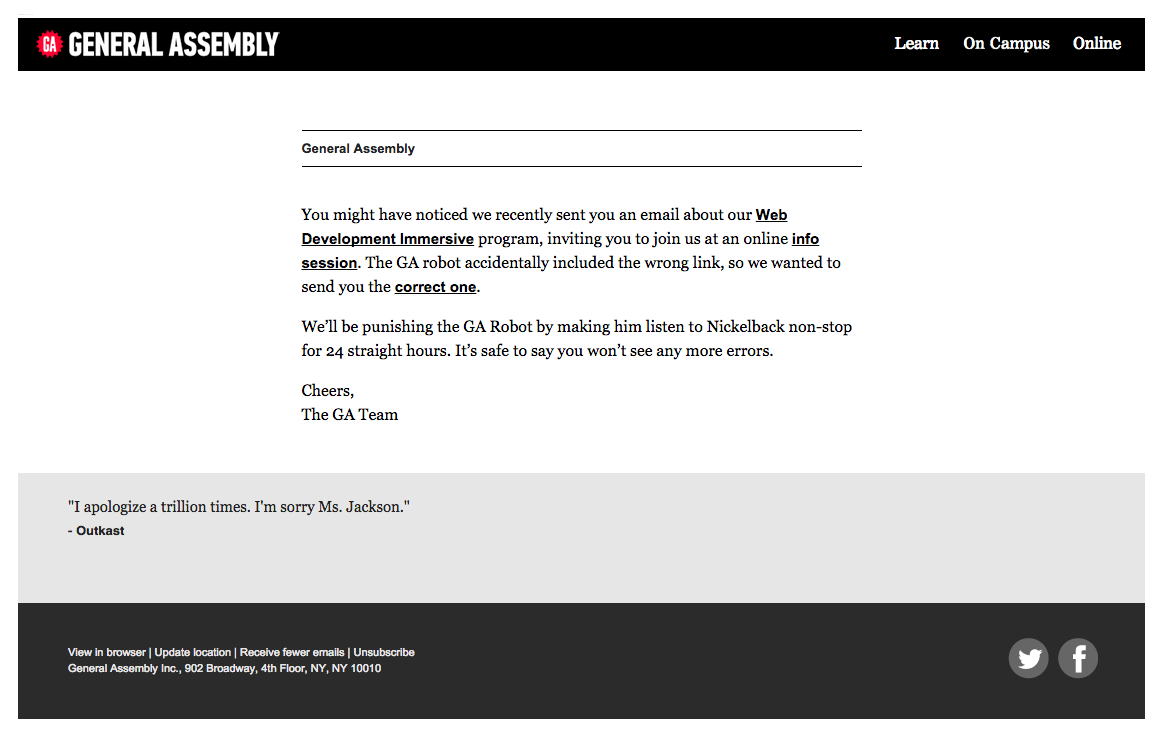
Clearly they're not afraid to laugh at themselves. They made a small mistake and they owned it.
I mean, how can you stay mad at someone who includes an Outkast quote in a marketing email?
Point being, if you're sending an apology email, don't beat around the bush. People will more than often appreciate your honesty over a long-winded, strategically crafted excuse.
Be human about it (or in this case, blame it on the robot.)
Writing content for everyone
Emails that try to appeal to everyone often appeal to no one.
They lack context, personalization, and any trace of a human element.
This is why segementation is so critical to the success of your emails campaigns. Rather than struggling to write blindly for a faceless audience, segmentation by persona, location, gender, or age helps to narrow the focus.
How to fix it:
If you have an opportunity to segment your emails, seize it.
If you do have to send out an email to a wide net of people, keep it simple.
Check out this email I got when I subscribed to theSkimm:
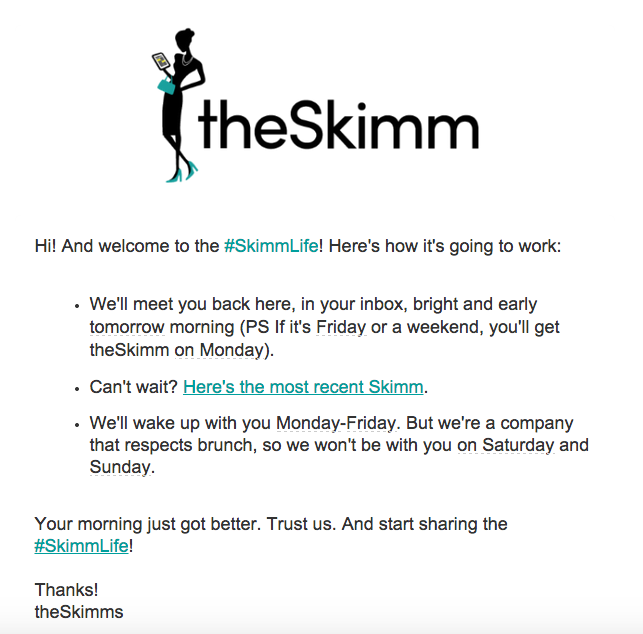
It's quick. It's casual. It reassures me that passing over my email was the right decision.
The language isn't doctored up with unnecessary words. It feels like it was written by human for a human, which is surprisingly uncommon in the world of marketing emails.
It also aims to set my expectations as a subscriber. There are no questions as to when and how frequently I will be receiving their updates.
Assuming they know you
Purchased email lists have never been and never will be a good solution.
Sending an email to someone who doesn't know you and doesn't care to know you will often result in an awkward, wasteful exchange.
But you're smarter than that, right? You'd never stoop as low as to buy a list, so why am I even talking about this?
According to MailChimp, most email experts say that even opt-in lists can begin to go stale after about six months.
If you haven't engaged with them in a while, people tend to forget that they've signed up.
This doesn't mean that you should give up on email all together, but rather it simply stresses that you shouldn't assume they remember you.
How to fix it:
Here's a great example from our former marketing director, John:
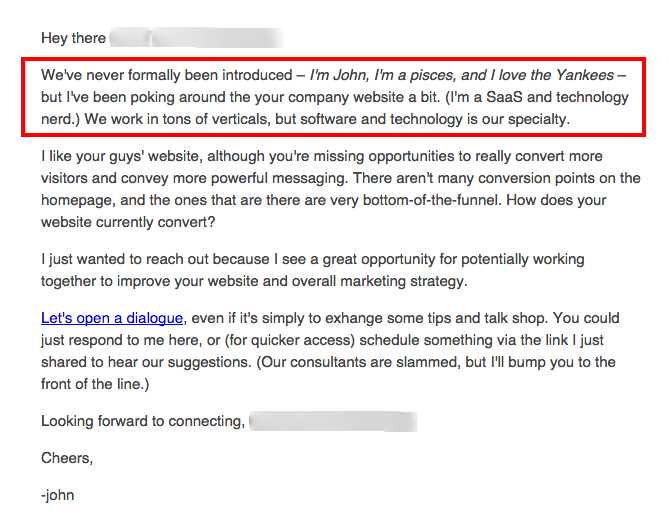
John knew that these people weren't sitting by their inbox waiting for his email to appear.
In fact, it was probably more of a "who's this John guy?" type of reaction, which is why the first line or two of his email is so effective.
Quick rule of thumb - If you think the recipients might have forgotten about you, it's likely that they have forgotten about you.
Neglecting the subject line
The subject line isn't something that you whip together at the last minute before you hit send.
In fact, many marketers would argue that subject lines are like an art form.
If you think about it, they are one of the only things standing between your email getting opened or trashed.
What can you write that is going to make people feel like they can't afford not to open your email?
How to fix it:
This example from Joanna at Copy Hackers is almost too good:
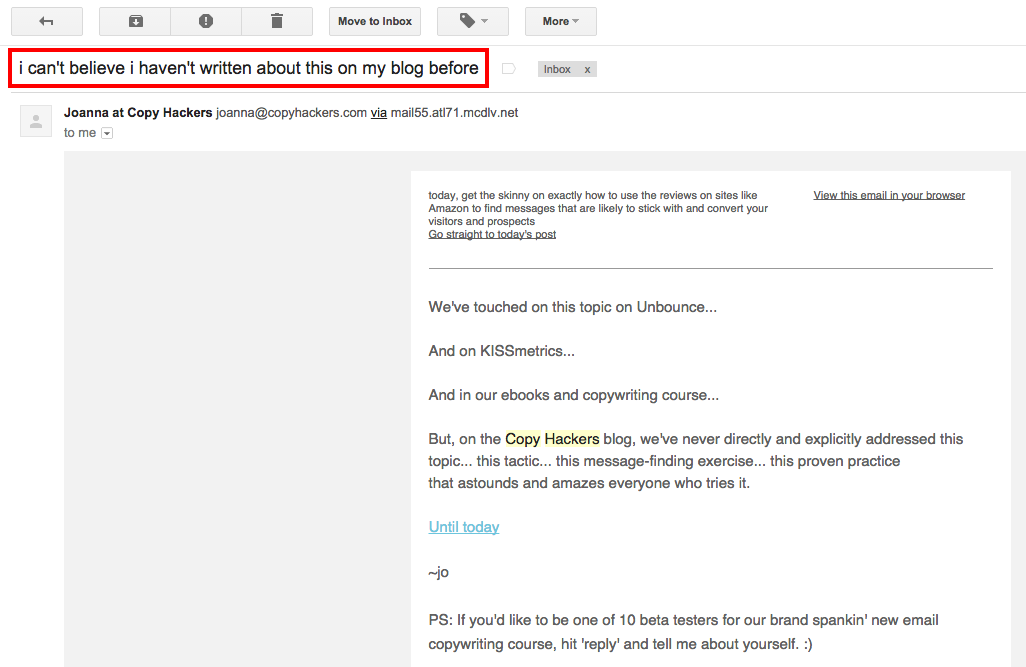
What Joanna does really well is create a level of intrigue that recipients can't ignore.
The trick to getting your email subject lines opened is to find a way to appeal to the recipients emotions, interests, and pain points.
I physically couldn't NOT open this email because I had to know the punchline.
Not optimizing for mobile
This year more than ever we've watched email migrate away from the desktop and onto mobile devices.
At this point, 64% of decision makers read their email on their mobile device. (Source: TopRankBlog)
Yet, only 31% of marketers know their mobile email open rate. (Source: Marketing Sherpa)
Notice the disconnect?
With decision makers active on their mobile devices, it's crucial that we're honing in on the optimization and performance of our emails.
How to fix it:
Switch to single column
While many emails employ multi-column layouts for desktop, the single-column approach is far more mobile-friendly. Not only does this style makes more sense in terms of usability on small screens, but it also contributes to improved readability.
Modify the content
When operating on a smaller screen, the amount of information a visitor can see at once is constricted. This means that they are forced to remember more, making long-winded content less than ideal.
Improve the mobile experience by taking the content from your desktop page and cutting it in half (at the very least.) Even short content is too long for mobile. Make it minimal.
Optimize buttons
Any and all calls-to-action within your emails should be touch-friendly.
To avoid strategic tapping and frustrated visitors, be sure that your buttons are large enough to be seen and accessed.
Need inspiration? Check out this example from Litmus that totally nails it:
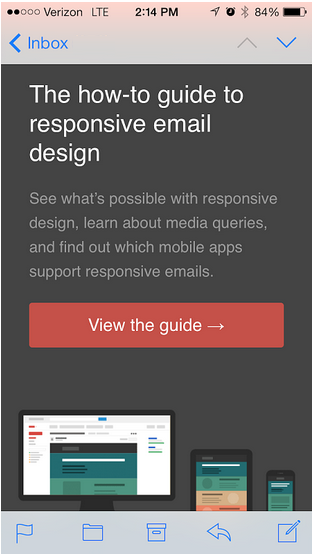
Clean. Clear. Legible.
Mishandling unsubscribes
Much like regular people, it's not okay to hold your blog subscribers hostage. I repeat, not okay.
Making it troublesome for recipients to unsubscribe is not only in bad taste, but it will often result in being blocked or flagged as spam (ouch.)
The more people that take action against your emails, the bigger the impact it will have on not only your reputation, but also your deliverability. Rather than landing a spot in their inbox, you can expect to come face-to-face with the spam folder every time.
How to fix it:
It's important to note that by law (CAN-SPAM Act), you're required to include an opt-out option in every email. In other words, failure to honor unsubscribe requests could land you in some serious hot water.
Our advice? Take each unsubscribe in stride.
People unsubscribe for more reasons that you can count. Maybe they switched careers and your insight is no longer relevant, or they simply can't afford another email in their inbox every morning.
If you do feel compelled to do or say something, consider taking a page from HubSpot's book:


Order Your Copy of Marcus Sheridan's New Book — Endless Customers!

